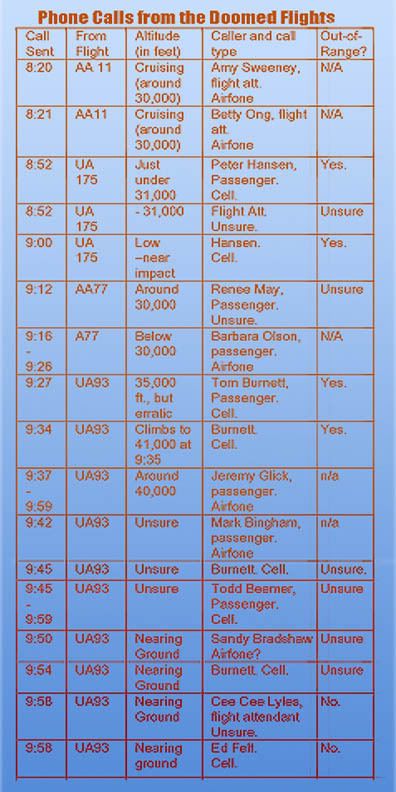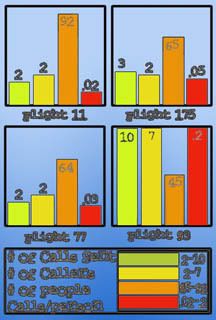Nonetheless, the audio record has its problems: Cockpit audio of the hijackers talking to the passengers was accidentally heard, recorded, and later presented from flights 11 and 93. That both Ziad Jarrah and Mohammed Atta would be able to run the hundreds of controls necessary to fly these monsters into their targets, but then both hit the transmit button instead of the cabin address button seems possible, but a little coincidental on two of the four flights. It seems almost as likely that these oddly feedback-laden transmissions were faked by, as Joe Vialls termed it, “an unidentified “special effects” department, perhaps hell-bent on making listeners later believe that the suitably distorted “guttural” voice belongs to an “Arab hijacker” trying to steal an American airliner.” [1]
Then there are the cockpit voice recordersby which we can normally hear what happened in the cockpit of a crashed plane. Flights 11, 175 and 77 yielded nothing (no indestructible black boxes found for any of them either, which is odd). But 93’s CVR yielded thirty minutes of audio thoroughly consistent with the inspirational official story. Family members of the victims on that flight have been allowed to listen to it but not talk about it. This means either there were hijackers and a cockpit intrusion on Flight 93, or else the CVR was simply switched off, with this recording planted in its memory before takeoff, or somehow faked later.
Otherwise the audio field is owned by phone calls from passenger and crew. The total number of calls to contend with is fairly low; only two to three calls each from flights 11, 77, and 175 have been published to my knowledge, in stark contrast to the flood of ten calls from Flight 93. Some of these calls were sent via “Airfone,” special phones built into and transmitted from the plane itself. They are designed to send phone signals from the air to the ground, offered in lieu of the FAA ban on cellular phones.
Others of the calls were placed via personal cell phones in spite of the ban, and it is to these that we now turn. In July 2004, American Airlines and Qualcomm jointly announced the development of a new technology that allowed passengers on a test flight “to place and receive calls as if they were on the ground.” [2] But what types of calls from the air were possible in 2001? Altitude seems to be the key. Canadian Economist and 9-11 revisionist Michel Chossudovsky explained “according to industry experts, beyond a certain altitude which is usually reached within a few minutes after takeoff, cell phone calls are no longer possible.” [3] This zone of reliability seems to have been about 8,000 feet, with normal cruising altitude around 30,000 feet, and thus, he concludes, “given the wireless technology available on September 11 2001, these cell calls could not have been placed from high altitude.” [4] Wireless Review explained: “Alexa Graf, AT&T spokesperson, said systems are not designed for calls from high altitudes, suggesting it was almost a fluke that the calls reached their destinations.” [5]

 |
And for what it’s worth, Flight 93 somehow wound up yielding ten times the calls per person ratio of flight 11, with more calls than from the other three flights combined. 93 yielded ten reported calls and seven callers out of only 33 non-terrorist passengers, in a plane that can seat 182. There is no reason to doubt the government’s ability to fake these few phone calls in any number of ways, nor their ability to place them in such a way that they bear all the marks of a genuine call from one of the hijacked flights, cell phone or Airfone. But on the other hand, multiple loved ones were totally convinced - if these were faked they were faked well. There are four possibilities that these calls and transmissions represent:
- a) Audio record real, hijackers present and in charge, and flew their planes into those buildings. Shadow 9/11 is bunk.
- b) Calls real, hijackers on board in a traditional hijacking scenario, with the well-known, widely warned attack then “hijacked” via remote control, leaving the obvious presumption that the Arabs did it.
- c) Calls fake, passengers but presumably no hijackers on board, as in Scenario 12-D. All communications would be cut so the outside world didn’t find out what was really going on inside the plane, and the audio we’ve been presented is entirely faked. In this case, any hijacking attack, as mentioned in warnings, would have been pre-emptively hijacked.
- d) Calls fake, no one on board the attack planes at all. The flights were drones every one, and who knows what happened with the passengers.
- e) Any permutation or combination of these – ex: Flight 93 may have been a real hijacking, traditional or suicide, with the other three planes being drones tacked on to the existing attack, using it as cover while amplifying its traumatic nature. If 93 were a genuine hijacking, it may have even been fitted with a special prototype system like Qualcomm’s to send cell calls as if from the ground to thickly document the real terrorist presence there. The plane was then presumably shot down on Dick Cheney’s orders as it headed to Washington, and was then presumed part of the otherwise faked attack.
And remember, the very integrity of the “new American Century” is at stake here. In scenario d) above, the final fate of the passengers on the attack planes is raised, and indeed there are many convoluted theories out there to explain this. For example, the four flights may have been told of a hijacking threat, crossed radar paths with duplicate drone aircraft, as in Northwoods, as they moved to land at a safe airport. The “rescued” passengers would have been off-loaded, then loaded onto flight 93 and shot down. But Shadow 9/11’s simplest explanation is that they were simply kept on their respective planes, killing two birds with one stone and keeping the evidence consistent.
Thus I can only cite questions about cell phone calls, raise the possibility of faked calls from remote locations, note the telling slant of the audio record toward one flight (93), and finally note that if one call from 9-11 is fake, and consistent with the other calls, then clearly all are fakes. But I can’t prove anything. This is not my field, and the audio record remains the weak point of Shadow 9/11. I’ll leave it to the reader whether to dismiss the whole theory for this flaw or overlook the flaw for the sake of the big picture.
Sources:
For the call chart, I referenced The Terror Timeline (2004) by Paul thompson and the Center for Cooperative Research. I thank them for their excellent work.
[1] Vialls, Joe. “‘We Have a Bomb on Board’ Messages Faked.” September 19, 2002. Accessed Nov. 16 2005 at: http://the7thfire.com/Politics%20and%20History/Faked-Flt93-messages.htm
[2], [4] Qualcomm. Press release. American Airlines and QUALCOMM Complete Test Flight to Evaluate In-Cabin Mobile Phone Use. July 15, 2004. Accessed January 9, 2005 at: http://www.qualcomm.com/press/releases/2004/040715_aa_testflight.html
[3] Chussudovsky, Michel. “Holes in the report, the 9/11 Cell Phone Calls.” Global Research. Aug 10, 2004. Accessed Nov 20 2005 at: http://inn.globalfreepress.com/modules/news/print.php?storyid=723&PHPSESSID=ce62971b5a6eba2e58aa8c0098173a38
[5] Harter, Betsy. “Final Contact” Wireless Review. November 1, 2001. Accessed January 9, 2005 at: http://wirelessreview.com/ar/wireless_final_contact/



No comments:
Post a Comment